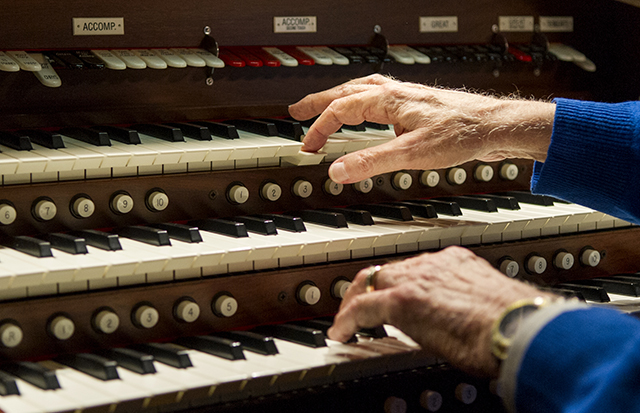One dentist’s enduring gift

Dr. Bill Hanson ’61 has gifted hands to be sure, but not just in the way you might think. Since 1960, these dexterous hands have guided the footsteps of thousands at one of Texas A&M University Baylor College of Dentistry’s most treasured annual rituals.
Hanson, 84, has shared his musical talent at TAMBCD commencement ceremonies even longer than the 35 years he practiced dentistry in Dallas. Seated at an organ console, dwarfed by hundreds of soaring brass pipes, Hanson’s success is measured in emotional impact and not empirical data; an experience forever instilled in the minds of graduates and their guests.
On a recent weekday, Hanson demonstrated his technique on a theater organ installed along one wall in the wood-paneled family room of his Dallas home. Giant sound emanates from speakers concealed behind fabric at one end of the vaulted ceiling.
“It’s amazing what they can do now with digital organ technology,” he comments while peering at enlarged sheet music through a pair of lighted eyeglasses with magnifying lenses. Macular degeneration is taking its toll on Hanson’s eyesight, but it’s not enough to keep him away from his music.
Up close he displays frenetic activity while navigating an instrument featuring several keyboards for the hands, wooden keys for the feet and dozens, even hundreds, of “stops” that can recreate the sound of almost any instrument. In Hanson’s tried-and-true sequence for programming the preset stops on any organ, No. 1 is the softer stuff; No. 10 is “like gangbusters.”
“I know my talent was given to me, and I had to expand on it,” he says, alluding to his faith in a God who endows each individual with unique gifts. He realizes fewer people are studying organ these days, particularly as many churches trend toward more contemporary worship music, but he exalts the “wonderful music” that can be achieved with a great church organ, the origins of which date back centuries.

Over the years Hanson’s musical gifts have taken him on some memorable adventures: performing in Dallas with famous composer and pianist Roger Williams from California, participating in a comedy routine featuring a snipped necktie and several flying sheet-music pages, and playing keyboard for a dance band during his teens and 20s.
“Being a pianist able to play pop music in high school is a real chick magnet,” he volunteers. “I never had trouble getting a date.” But after spying his future wife, Jean, on the steps of a Greenville, Miss., Baptist church, Hanson’s heart has been hers alone for 63 years. They have lived in the same home for 47 years and have three daughters and eight grandchildren.
Hanson was the organist at Dallas’ First Baptist Church for 15 years and at Prestonwood Baptist Church for eight years, but his musical roots trace back seven decades to his childhood in Cambridge, Wis. There he performed for the Presbyterian church and even played a theatre organ in town every Saturday to the chagrin of his teacher, who underestimated his ability to play “by ear” without sheet music.
During college at the University of Wisconsin, he spent Sundays behind the organ and directing the choir at a large Lutheran church near Madison. His organ playing days continued during his service in the Air Force.
Later during dental school, he spent each Thursday morning accompanying the Baylor Chorus during mandatory weekly chapel services for students at what was then a Baptist-affiliated institution. He landed his first TAMBCD commencement gig when he was still a dental student. His last occurred this May, 55 years later.
“Over the years you figure out what works and what doesn’t,” Hanson explains of the accompaniment for commencement processionals, which can last as long as 20 minutes. “For one thing, I have all of that music memorized. I don’t just open the music and play it. I ease into three different songs in the same key, not one song played over and over again.”
He has the power to “jar people’s teeth” with a musical blast if he chooses, but instead Hanson harnesses the organ’s potential to evoke a mood through judicious selection of stops and orchestration.
“I wrote a fanfare that I use between the faculty and student processionals so I can build into the big sound of the organ when the students enter,” he explains. “When I play the ending I try to do that as the last student is entering the row, then I go into a big chord change for 15 seconds as an exclamation point at the end of the song.”
Whether literal or symbolic, that sonorous finale heralds a beautiful beginning for a new class of graduates.